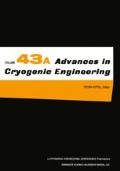Abstract
Progress in the development of a cryogenic catheter to treat heart arrhythmia is discussed. This system uses a mixed-gas Joule-Thomson (J-T) refrigerator to cool the tip of a catheter that can be inserted into the body through the large veins leading into the heart. The cryogenic catheter is intended to treat heart arrhythmia characterized by an abnormally rapid heart rate, although the system has a wide variety of other medical applications. Approximately 2 million people in the U.S. suffer from rapid-rate heart arrhythmia. Catheter therapy has proven to be a more effective and less expensive method of treatment than alternatives such as drugs or surgery. A cryogenic catheter has significant advantages over existing catheters used in this form of therapy. The catheter has coaxial tubes for the high and low pressure streams with a miniature heat exchanger and J-T orifice at the catheter tip. The high pressure is maintained at 2.5 MPa. The largest diameter is 3 mm, the length is 90 cm, and all but the last 10–20 mm is flexible. The gas mixture has been optimized for the required operating conditions using nonflammable and low ozone depletion gases. Low cost techniques have been incorporated into the fabrication of the cold tip so that each catheter can be disposable. Several prototype catheters have been built. No-load temperatures down to 85 K were achieved with the cold tip exposed to ambient air. Using room temperature gelatin to simulate tissue heat loads, catheter tip temperatures of 160 to 175 K have been achieved, and ice balls about 26 mm in diameter weighing 11 g were created. We estimate that ice balls about 10 mm in diameter weighing 1.5 to 2.0 g are required to treat ventricular arrhythmia. Although the heat load in our experiments was less than the in vivo load, we think the current refrigeration power is sufficient to meet the clinical requirement.
Contribution of the National Institute of Standards and Technology, not subject to copyright in the U.S.
Access this chapter
Tax calculation will be finalised at checkout
Purchases are for personal use only
Preview
Unable to display preview. Download preview PDF.
References
W.J. Podbielniak. “Art of Refrigeration,” U.S. Patent 2,041,725 (1936).
A.P. Kleemenko, “One Flow Cascade Cycle (in schemes of natural gas liquefaction and separation),” International Institute of Refrigeration (1959), paper 1-a-6.
D.J. Missimer, “Auto-Refrigerating Cascade (ARC) Systems — an Overview,” Tenth Intersociety Cryogenic Symposium, AIChE Spring National Meeting (March, 1994).
W. A. Little and I. Sapozhnikov, “Low Cost Cryocoolers for Cryoelectronics,” Cryocoolers 9, Plenum Press, New York, 1997, p. 509.
M. Fuderer and A. Andrija, Verfahren zur Tiefkühling, German Patent 1426956 (1969).
V.N. Alfeev, V.M. Brodyanski, V.M. Yagodin, V.A. Nikolsky, and A.V. Ivantsov, “Refrigerant for a Cryogenic Throttling Unit,” UK Patent 1,336,892 (1973).
W. A. Little, “Advances in Joule-Thomson Cooling”, Advances in Cryogenic Engineering, Vol. 35, Plenum Press, New York, 1990, p. 1305.
R.C. Longsworth, “Cryogenic Refrigerator with Single Stage Compressor,” U.S. Patent 5,337,572(1994).
R.C. Longsworth, M.J. Boiarski, and L.A. Klusmier, “80 K Closed-Cycle Throttle Refrigerator,” Cryocoolers 8, Plenum Press, NY (1995) p. 537.
R. Radebaugh, E. Marquardt, J. Dobak, and M. Huber, “Mixed Gas Refrigeration Method,” U.S Patent number to be issued (1996).
NIST Mixture Property Program (DDMIX) (NIST14, Version 9.09), National Institute of Standards and Technology, Gaithersburg, MD, 1992.
Dr. Hans Quack, Techn. Universität Dresden, private communication (1997).
H.P. Lenz and J. Eichler, Cryobiology, Volume 13, p. 37–46, 1976.
Author information
Authors and Affiliations
Editor information
Editors and Affiliations
Rights and permissions
Copyright information
© 1998 Springer Science+Business Media New York
About this chapter
Cite this chapter
Marquardt, E.D., Radebaugh, R., Dobak, J. (1998). A Cryogenic Catheter for Treating Heart Arrhythmia. In: Kittel, P. (eds) Advances in Cryogenic Engineering. Advances in Cryogenic Engineering, vol 43. Springer, Boston, MA. https://doi.org/10.1007/978-1-4757-9047-4_113
Download citation
DOI: https://doi.org/10.1007/978-1-4757-9047-4_113
Publisher Name: Springer, Boston, MA
Print ISBN: 978-1-4757-9049-8
Online ISBN: 978-1-4757-9047-4
eBook Packages: Springer Book Archive

